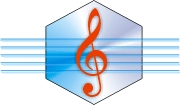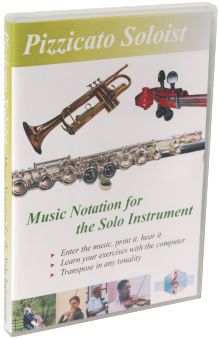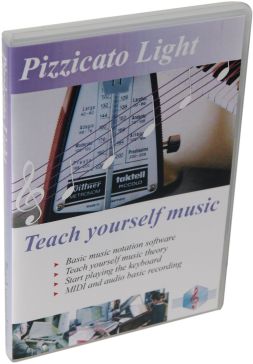Percussion notation
Pizzicato
Professional includes several tools to write percussion
instruments. First you can
select the number of lines in a staff. It is common to write the
orchestra percussion instruments on one line. To do that: Select the
cursor (arrow tool) and double-click to the right of the
percussion staff A combo
menu entitled "Number of staff lines" lets you
select between 0 and 16 lines The
"***" choice of this menu opens a dialog box
with which you can select the staff lines to draw. You
can for instance have a staff with lines 1, 3 and 5,
which means 3 lines with larger space in between, where
you can write for example 3 different percussion
instruments. Click OK
and the staff will be redrawn with the specified number
of lines. You can
modify the clef using for example the percussion clef
(little rectangle). You can place it using the clef tool. If the
other staves of the score have a key signature, you can
remove that key signature for the percussion staves using
the key signature tool. You need to call the key
signature dialog box, select the Major C key signature
and check the "Only for this staff" box. Sometimes the notes
heads are modified to write the percussions, to distinguish each
instrument. The cymbal is often drawn with a cross note. The note
head tool can thus be used to personalize the percussion
instruments, for one note at a time or for all the notes of one
or several measures (Edit menu, Change the notes heads...). The last point is
important only when you want to hear the score with correct
percussion instruments. Often, in a synthesizer or a sound card,
percussions are assigned to a keyboard key. For example the
cymbal, the snare drum, the bass drum,... have each one an
equivalent note on the musical keyboard with which to play them.
The GM (General Midi) standard assigns in this way a percussion
map to specify the instrument corresponding to C, the one
corresponding to C #,... Maybe this distribution is practical on
the musical keyboard, but if you write then your percussion part
on one staff, the score is very difficult to read, because the
instruments seem ordered in an arbitrary way (example : a bass
drum with 5 additional lines, an instrument with a B flat but
very acute,...). Pizzicato includes
a tool to reassign each percussion instrument to a specific line
of the staff. In this way, you can specify your notation
conventions: if you want for example a low C for the bass drum,
an high C for the snare drum, you decide. You can reach the
percussion map as follows: Open the
instrument view and select the "MIDI
Parameters" item in the scroll menu which appears
while clicking in the top left corner of this window. The
"Pr" column is Percussion. Check it for the staff/staves
you want to reassign. A dialog
box appears and you can assign a percussion instrument to
each note of each octave with a scroll menu. You can then write
your notes as you want and Pizzicato will play the percussions
correctly. These tools help
you easily write most percussion parts of a score. For printing
and for listening.

All rights reserved for all countries
Pizzicato is a trademark owned by Arpege sprl





























